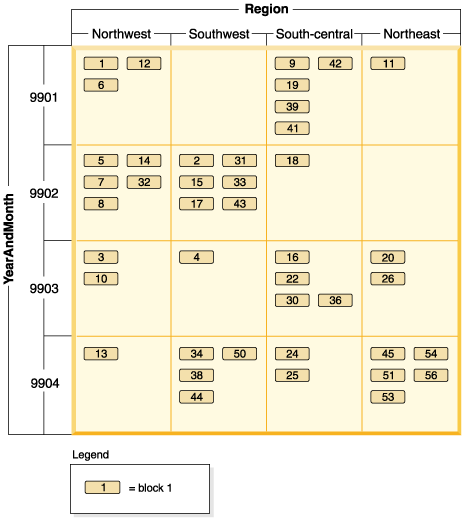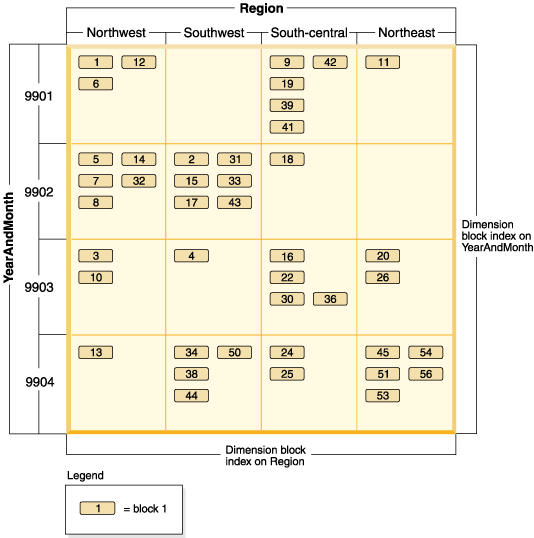As a scenario of how to work with an MDC table, we will imagine an MDC table called "Sales" that records sales data for a national retailer. The table is clustered along the dimensions "YearAndMonth" and "Region". Records in the table are stored in blocks, which contain enough consecutive pages on disk to fill an extent.
In Figure 1, a block is represented by a rectangle, and is numbered according to the logical order of allocated extents in the table. The grid in the diagram represents the logical database partitioning of these blocks, and each square represents a logical cell. A column or row in the grid represents a slice for a particular dimension. For example, all records containing the value 'South-central' in the "Region" column are found in the blocks contained in the slice defined by the 'South-central' column in the grid. In fact, each block in this slice also only contains records having 'South-central' in the "Region" field. Thus, a block is contained in this slice or column of the grid if and only if it contains records having 'South-central' in the "Region" field.

To determine which blocks comprise a slice, or equivalently, which blocks contain all records having a particular dimension key value, a dimension block index is automatically created for each dimension when the table is created.
In Figure 2, a dimension block index is created on the "YearAndMonth" dimension, and another on the "Region" dimension. Each dimension block index is structured in the same manner as a traditional RID index, except that at the leaf level the keys point to a block identifier (BID) instead of a record identifier (RID). A RID identifies the location of a record in the table by a physical page number and a slot number - the slot on the page where the record is found. A BID represents a block by the physical page number of the first page of that extent, and a dummy slot (0). Because all pages in the block are physically consecutive starting from that one, and we know the size of the block, all records in the block can be found using this BID.
A slice, or the set of blocks containing pages with all records having a particular key value in a dimension, will be represented in the associated dimension block index by a BID list for that key value.

Figure 3 shows how a key from the dimension block index on "Region" would appear. The key is made up of a key value, namely 'South-central', and a list of BIDs. Each BID contains a block location. In Figure 3, the block numbers listed are the same that are found in the 'South-central' slice found in the grid for the Sales table (see Figure 1).

Similarly, to find the list of blocks containing all records having '9902' for the "YearAndMonth" dimension, look up this value in the "YearAndMonth" dimension block index, shown in Figure 4.
